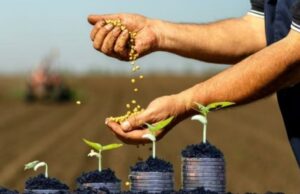Официальные стандарты США на зерно
Подраздел I – стандарты США на сорго
Subpart I – U.S. standards for sorghum
Terms Defined
810.1401 Definition of sorghum.
Grain that, before the removal of dockage, consists of 50 percent or more of whole kernels of sorghum (Sorghum bicolor (L.) Moench) excluding nongrain sorghum and not more than 10.0 percent of other grains for which standards have been established under the United States Grain Standards Act.
810.1402 Definitions of other terms.
(a) Broken kernels. All matter which passes through a 5/64 triangular-hole sieve and over a 2.5/64 round-hole sieve according to procedures prescribed in FGIS instructions.
(b) Broken kernels and foreign material. The combination of broken kernels and foreign material as defined in paragraphs (a) and (f) of this section.
(c) Classes. There are four classes of sorghum: Sorghum, Tannin sorghum, White sorghum, and Mixed sorghum.
(1) Sorghum. Sorghum which is low in tannin content due to the absence of a pigmented testa (subcoat) and contains less than 98.0 percent White sorghum and not more than 3.0 percent Tannin sorghum. The pericarp color of this class may appear white, yellow, pink, orange, red, or bronze.
(2) Tannin sorghum. Sorghum which is high in tannin content due to the presence of a pigmented testa (subcoat) and contains not more than 10.0 percent non-Tannin sorghum. The pericarp color of this class is usually brown but may also be white, yellow, pink, orange, red, or bronze.
(3) White sorghum. Sorghum which is low in tannin content due to the absence of a pigmented testa (subcoat) and contains not more than 2.0 percent sorghum of other classes. The pericarp color of this class is white or translucent and includes sorghum containing spots that, singly or in combination, cover 25.0 percent or less of the kernel.
(4) Mixed sorghum. Sorghum which does not meet the requirements for any of the classes Sorghum, Tannin sorghum, or White sorghum.
(d) Damaged kernels. Kernels, pieces of sorghum kernels, and other grains that are badly ground-damaged, badly weather-damaged, diseased, frost-damaged, germ-damaged, heat-damaged, insect-bored, mold-damaged, sprout-damaged, or otherwise materially damaged.
(e) Dockage. All matter other than sorghum that can be removed from the original sample by use of an approved device according to procedures prescribed in FGIS instructions. Also, underdeveloped, shriveled, and small pieces of sorghum kernels removed in properly separating the material other than sorghum.
(f) Foreign material. All matter, except sorghum, which passes over the number 6 riddle and all matter other than sorghum that remains on the top of the 5/64 triangular-hole sieve according to procedures prescribed in FGIS instructions.
(g) Heat-damaged kernels. Kernels, pieces of sorghum kernels, and other grains that are materially discolored and damaged by heat.
(h) Nongrain sorghum. Seeds of broomcorn, Johnson-grass, Sorghum almum Parodi, sorghum-sudangrass, hybrids, sorgrass, sudangrass, and sweet sorghum (sorgo).
(i) Pericarp. The pericarp is the outer layers of the sorghum grain and is fused to the seedcoat.
(j) Sieves.
(1) 1.98 mm (5/64 (0.0781) inches) triangular-hole sieve. A metal sieve 0.81 mm (0.032 inches) thick with equilateral triangular perforations the inscribed circles of which are 1.98 mm (0.0781 inches) in diameter.
(2) 0.99 mm (2/64 (0.0391) inches) round-hole sieve. A metal sieve 0.81 mm (0.032 inch) thick with round holes 0.99 mm (0.0391 inches) in diameter.
Principles Governing the Application of Standards
810.1403 Basis of determination.
Each determination of broken kernels and foreign material is made on the basis of the grain when free from dockage. Each determination of class, damaged kernels, heat-damaged kernels, and stones is made on the basis of the grain when free from dockage and that portion of the broken kernels and foreign material that will pass through a 1.98 mm (5/64 inch) triangular-hole sieve. Other determinations not specifically provided for in the General Provisions are made on the basis of the grain as a whole except the determination of odor is made on either the basis of the grain as a whole or the grain when free from dockage, broken kernels, and foreign material removed by the 1.98 mm (5/64 inch) triangular-hole sieve.
Sorghum Grades and Grade Requirements
810.1404 – Grades and Grade Requirements
| Grades U.S. Nos.* | ||||
|---|---|---|---|---|
| 1 | 2 | 3 | 4 | |
| Minimum pound limits of– | ||||
| Test weight (lbs./bu.) | 57.0 | 55.0 | 53.0 | 51.0 |
| Maximum percent limits of– | ||||
| DAMAGED KERNELS Heat (part of total) Total BROKEN KERNELS AND FOREIGN MATERIAL Foreign material (part of total) Total |
0.2 2.0 1.5 |
0.5 5.0 2.5 |
1.0 10.0 3.5 |
3.0 15.0 4.5 |
| Maximum count limits of– | ||||
| OTHER MATERIAL Animal filth Castor beans Crotalaria seeds Glass Stones** Unknown foreign substance Cockleburs |
9 1 2 1 7 3 7 |
9 1 2 1 7 3 7 |
9 1 2 1 7 3 7 |
9 1 2 1 7 3 7 |
U.S. Sample grade is sorghum that:
(a) Does not meet the requirements for U.S. Nos. 1, 2, 3, or 4; or
(b) Has a musty, sour, or commercially objectionable foreign odor (except smut odor); or
(c) Is badly weathered, heating, or distinctly low quality.
*Sorghum which is distinctly discolored shall not grade higher than U.S. No. 3.
**Aggregate weight of stones must also exceed 0.2 percent of the sample weight.
Special Grades and Special Grade Requirements
810.1405 Special grades and special grade requirements.
Smutty sorghum. Sorghum that has kernels covered with smut spores to give a smutty appearance in mass, or that contains 20 or more smut balls in 100 grams of sorghum.
(по состоянию на 1 июня 1997 г.)






